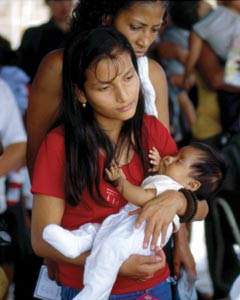Perspectives in Health Magazine
The Magazine of the Pan American Health Organization
Volume 8, Number 2, 2003

|
Perspectives in Health Magazine |
 |
|
An Act of Love Vaccination Week in the Americas by Manuel Calvit - Photos by Armando Waak 
The whistle of a teakettle pierces the morning silence, and the clock strikes six. It is June 1, 2003. Today and throughout this week, children in 19 Latin American and Caribbean countries will be the focus of attention for doctors, community leaders, politicians, volunteers, mothers and fathers. Together they will vaccinate millions of children wherever they are, no matter how remote their villages, no matter how difficult to reach. Measles is one of humanity's most contagious diseases and continues to be the main cause of vaccine-preventable death in the world, claiming the lives of some 770,000 children under the age of 5 each year. Before a vaccine became available in 1963, nearly all children got measles. Then in 1994, two historic achievements were announced at the Pan American Sanitary Conference in Washington, D.C. Latin America was declared free of polio (Luis Fermín Tenorio, a young boy from Pichanaquí, Peru, was the last known case). Second, all the region's countries united in an effort to interrupt indigenous transmission of measles. Since then, the region's countries have focused impressive efforts and resources on this goal. The Pan American Health Organization (PAHO) developed a measles eradication strategy based on better surveillance, targeted immunization and improved laboratory capacity. The sheer magnitude of the problem has meant delays; new outbreaks occurred in the 1960s in Argentina, Bolivia and Brazil, and in 2000-01 in Haiti and the Dominican Republic. But vaccination efforts continued, and between November 2002 and July 2003 there was no indigenous transmission of measles anywhere in the Americas. Keeping the region measlesfree, however, requires maintaining high levels of childhood vaccination. Andean ministers of health meeting last April proposed an Andean vaccination week. The idea was soon expanded to include South America and later Mexico, Central America and the Caribbean. Eventually 19 countries joined together for the first Vaccination Week in the Americas. The focus was on children who had never been vaccinated: those in hard-to-reach rural areas or marginal urban zones whom earlier campaigns had left behind. The campaign also helped reinforce key concepts of international public health: that joint efforts can lead to great achievements; that health is a bridge to solidarity, understanding and hope; and that vaccination is an individual right as well as an important tool of public health. In this spirit, countries mobilized their own resources and won support from agencies such as the U.S. Centers for Disease Control and Prevention, the United Nations Children's Fund and PAHO. Finally, Argentina, Bahamas, Bolivia, Brazil, Chile, Colombia, Costa Rica, Ecuador, El Salvador, Guatemala, Honduras, Jamaica, Mexico, Nicaragua, Paraguay, Peru, Suriname, Uruguay and Venezuela signed on to the historic initiative. Officials and health workers at all levels-ministerial, local and community- met daily through May 30, 2003, to make sure that the required personnel, equipment, vehicles and vaccines would all be in place for the week-long campaign. |